Value and Contribution of HR to TESCO's Organizational Success Report
VerifiedAdded on 2021/02/21
|9
|2815
|37
Report
AI Summary
This report analyzes the value and contribution of Human Resources (HR) to the organizational success of TESCO plc. It begins with an introduction to TESCO, including its organizational structure, which is identified as a line & staff structure, and its use of a divisional structure. The report explores organizational design, contrasting traditional and contemporary designs, and highlighting the importance of organizational design in achieving business goals, with TESCO's focus on a contemporary matrix approach. It then investigates two approaches, qualitative and quantitative, to ensure HR contributes to organizational design, along with HR techniques such as performance appraisal, employee relations, and human resource planning. Furthermore, the report examines emerging HR developments, such as the use of LinkedIn for recruitment and artificial intelligence, and how TESCO adapts HR practices to the changing internal and external environments. The second part of the report, though covered in a separate poster project, addresses change management theories, the role of HR in managing change, and the adaptation of organizational design to proposed changes, concluding with recommendations for HR implementation. Overall, the report emphasizes HR's critical role in TESCO's strategic objectives and its adaptability to the dynamic business landscape.
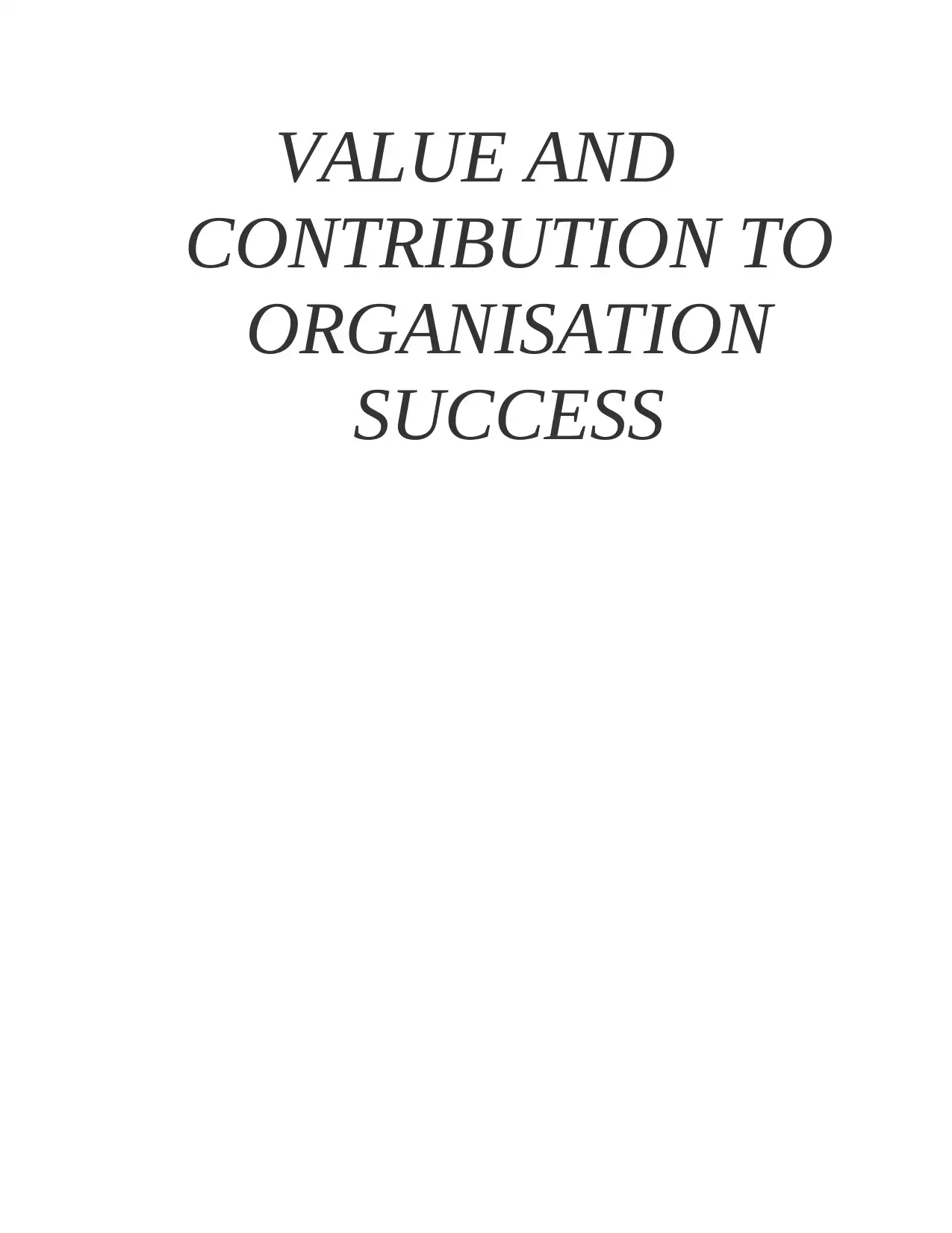
VALUE AND
CONTRIBUTION TO
ORGANISATION
SUCCESS
CONTRIBUTION TO
ORGANISATION
SUCCESS
Paraphrase This Document
Need a fresh take? Get an instant paraphrase of this document with our AI Paraphraser
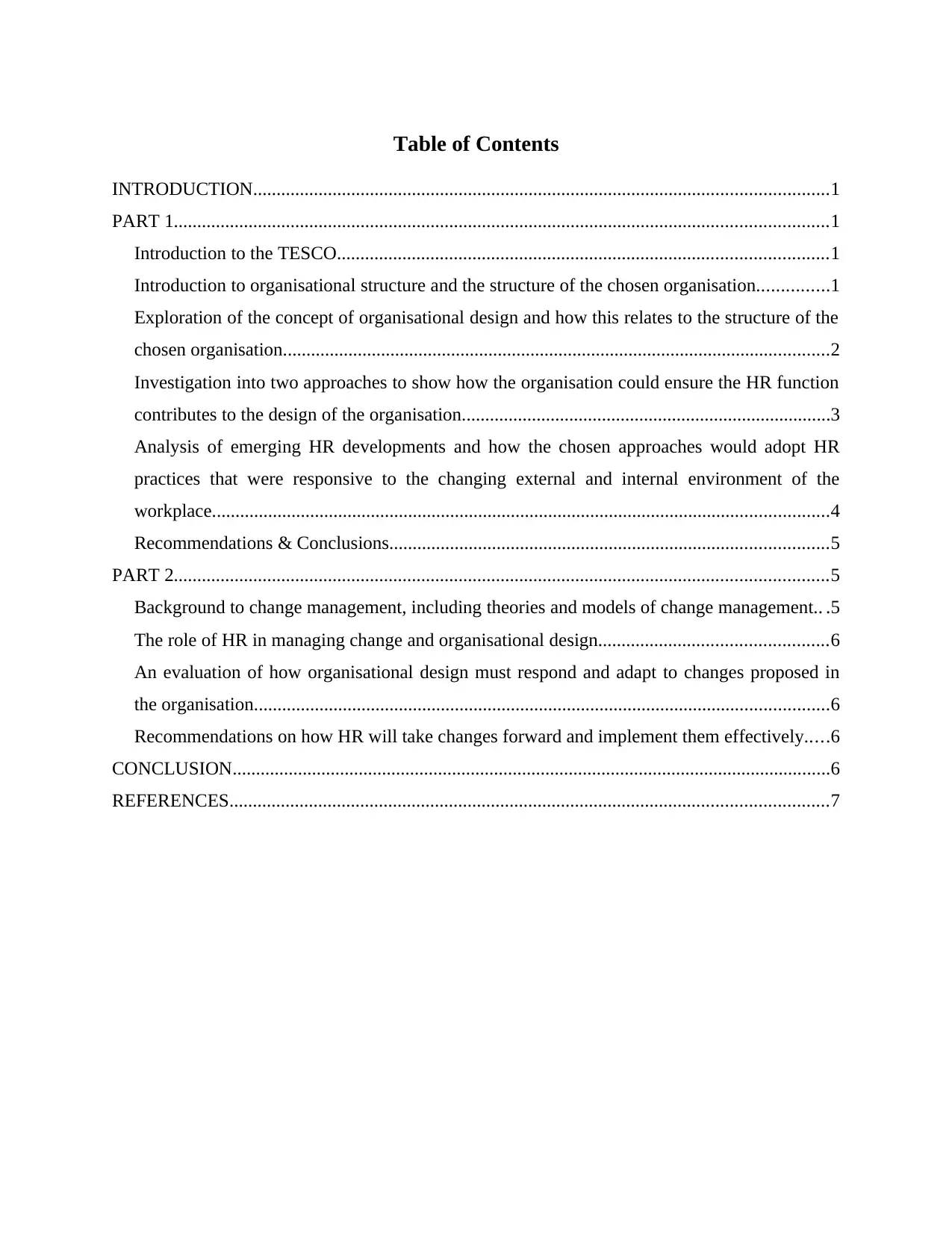
Table of Contents
INTRODUCTION...........................................................................................................................1
PART 1............................................................................................................................................1
Introduction to the TESCO.........................................................................................................1
Introduction to organisational structure and the structure of the chosen organisation...............1
Exploration of the concept of organisational design and how this relates to the structure of the
chosen organisation.....................................................................................................................2
Investigation into two approaches to show how the organisation could ensure the HR function
contributes to the design of the organisation...............................................................................3
Analysis of emerging HR developments and how the chosen approaches would adopt HR
practices that were responsive to the changing external and internal environment of the
workplace....................................................................................................................................4
Recommendations & Conclusions..............................................................................................5
PART 2............................................................................................................................................5
Background to change management, including theories and models of change management.. .5
The role of HR in managing change and organisational design.................................................6
An evaluation of how organisational design must respond and adapt to changes proposed in
the organisation...........................................................................................................................6
Recommendations on how HR will take changes forward and implement them effectively.....6
CONCLUSION................................................................................................................................6
REFERENCES................................................................................................................................7
INTRODUCTION...........................................................................................................................1
PART 1............................................................................................................................................1
Introduction to the TESCO.........................................................................................................1
Introduction to organisational structure and the structure of the chosen organisation...............1
Exploration of the concept of organisational design and how this relates to the structure of the
chosen organisation.....................................................................................................................2
Investigation into two approaches to show how the organisation could ensure the HR function
contributes to the design of the organisation...............................................................................3
Analysis of emerging HR developments and how the chosen approaches would adopt HR
practices that were responsive to the changing external and internal environment of the
workplace....................................................................................................................................4
Recommendations & Conclusions..............................................................................................5
PART 2............................................................................................................................................5
Background to change management, including theories and models of change management.. .5
The role of HR in managing change and organisational design.................................................6
An evaluation of how organisational design must respond and adapt to changes proposed in
the organisation...........................................................................................................................6
Recommendations on how HR will take changes forward and implement them effectively.....6
CONCLUSION................................................................................................................................6
REFERENCES................................................................................................................................7
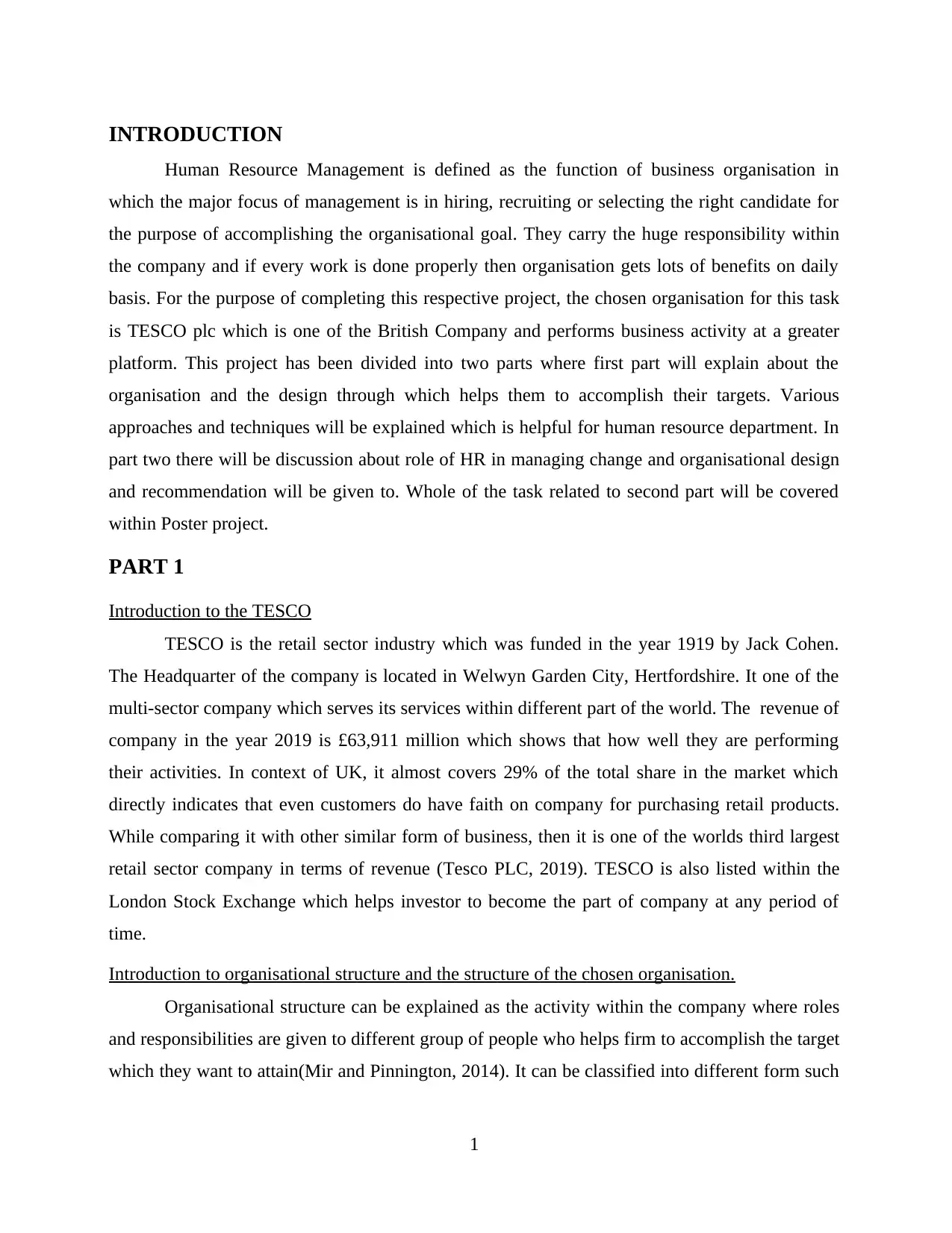
INTRODUCTION
Human Resource Management is defined as the function of business organisation in
which the major focus of management is in hiring, recruiting or selecting the right candidate for
the purpose of accomplishing the organisational goal. They carry the huge responsibility within
the company and if every work is done properly then organisation gets lots of benefits on daily
basis. For the purpose of completing this respective project, the chosen organisation for this task
is TESCO plc which is one of the British Company and performs business activity at a greater
platform. This project has been divided into two parts where first part will explain about the
organisation and the design through which helps them to accomplish their targets. Various
approaches and techniques will be explained which is helpful for human resource department. In
part two there will be discussion about role of HR in managing change and organisational design
and recommendation will be given to. Whole of the task related to second part will be covered
within Poster project.
PART 1
Introduction to the TESCO
TESCO is the retail sector industry which was funded in the year 1919 by Jack Cohen.
The Headquarter of the company is located in Welwyn Garden City, Hertfordshire. It one of the
multi-sector company which serves its services within different part of the world. The revenue of
company in the year 2019 is £63,911 million which shows that how well they are performing
their activities. In context of UK, it almost covers 29% of the total share in the market which
directly indicates that even customers do have faith on company for purchasing retail products.
While comparing it with other similar form of business, then it is one of the worlds third largest
retail sector company in terms of revenue (Tesco PLC, 2019). TESCO is also listed within the
London Stock Exchange which helps investor to become the part of company at any period of
time.
Introduction to organisational structure and the structure of the chosen organisation.
Organisational structure can be explained as the activity within the company where roles
and responsibilities are given to different group of people who helps firm to accomplish the target
which they want to attain(Mir and Pinnington, 2014). It can be classified into different form such
1
Human Resource Management is defined as the function of business organisation in
which the major focus of management is in hiring, recruiting or selecting the right candidate for
the purpose of accomplishing the organisational goal. They carry the huge responsibility within
the company and if every work is done properly then organisation gets lots of benefits on daily
basis. For the purpose of completing this respective project, the chosen organisation for this task
is TESCO plc which is one of the British Company and performs business activity at a greater
platform. This project has been divided into two parts where first part will explain about the
organisation and the design through which helps them to accomplish their targets. Various
approaches and techniques will be explained which is helpful for human resource department. In
part two there will be discussion about role of HR in managing change and organisational design
and recommendation will be given to. Whole of the task related to second part will be covered
within Poster project.
PART 1
Introduction to the TESCO
TESCO is the retail sector industry which was funded in the year 1919 by Jack Cohen.
The Headquarter of the company is located in Welwyn Garden City, Hertfordshire. It one of the
multi-sector company which serves its services within different part of the world. The revenue of
company in the year 2019 is £63,911 million which shows that how well they are performing
their activities. In context of UK, it almost covers 29% of the total share in the market which
directly indicates that even customers do have faith on company for purchasing retail products.
While comparing it with other similar form of business, then it is one of the worlds third largest
retail sector company in terms of revenue (Tesco PLC, 2019). TESCO is also listed within the
London Stock Exchange which helps investor to become the part of company at any period of
time.
Introduction to organisational structure and the structure of the chosen organisation.
Organisational structure can be explained as the activity within the company where roles
and responsibilities are given to different group of people who helps firm to accomplish the target
which they want to attain(Mir and Pinnington, 2014). It can be classified into different form such
1
⊘ This is a preview!⊘
Do you want full access?
Subscribe today to unlock all pages.

Trusted by 1+ million students worldwide
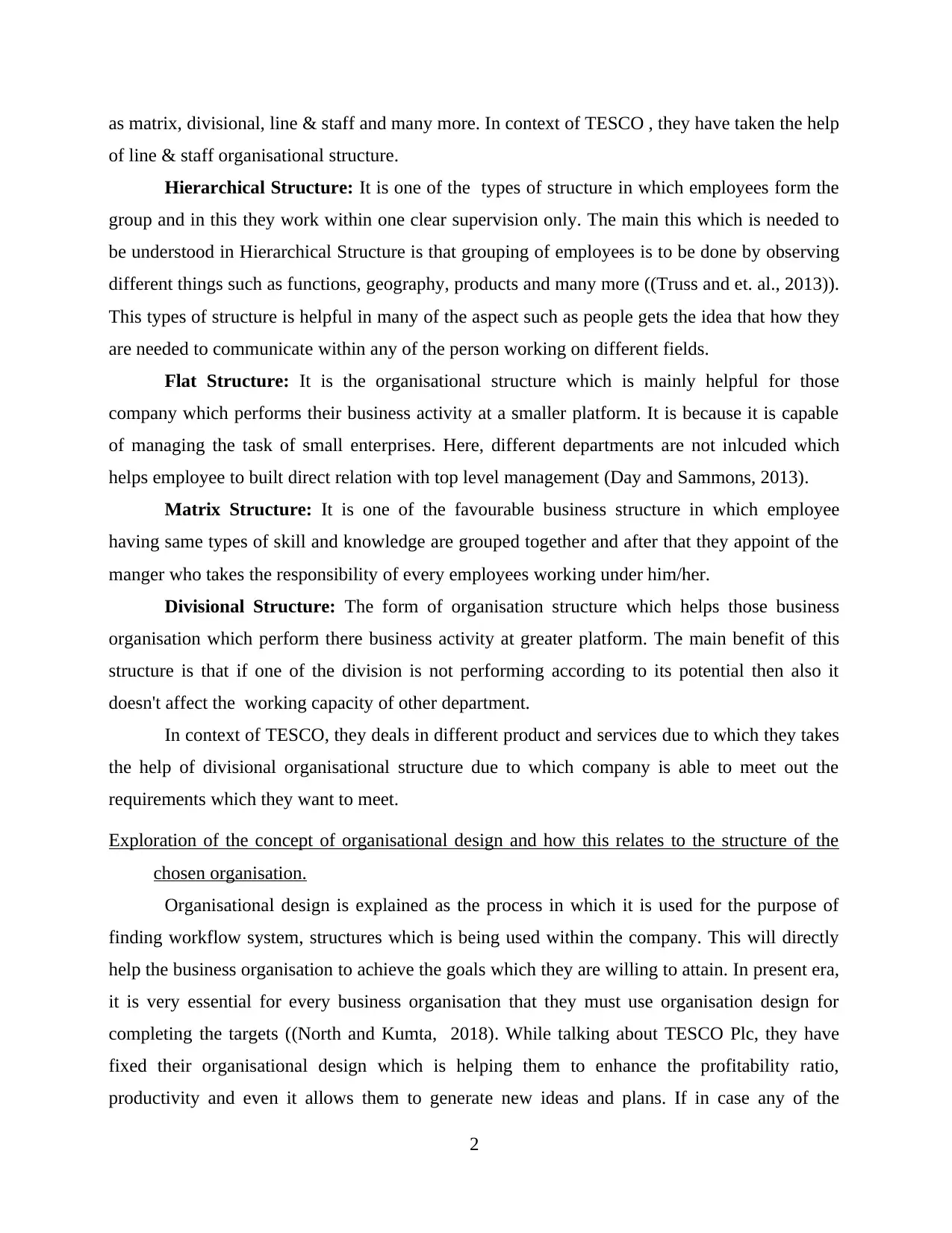
as matrix, divisional, line & staff and many more. In context of TESCO , they have taken the help
of line & staff organisational structure.
Hierarchical Structure: It is one of the types of structure in which employees form the
group and in this they work within one clear supervision only. The main this which is needed to
be understood in Hierarchical Structure is that grouping of employees is to be done by observing
different things such as functions, geography, products and many more ((Truss and et. al., 2013)).
This types of structure is helpful in many of the aspect such as people gets the idea that how they
are needed to communicate within any of the person working on different fields.
Flat Structure: It is the organisational structure which is mainly helpful for those
company which performs their business activity at a smaller platform. It is because it is capable
of managing the task of small enterprises. Here, different departments are not inlcuded which
helps employee to built direct relation with top level management (Day and Sammons, 2013).
Matrix Structure: It is one of the favourable business structure in which employee
having same types of skill and knowledge are grouped together and after that they appoint of the
manger who takes the responsibility of every employees working under him/her.
Divisional Structure: The form of organisation structure which helps those business
organisation which perform there business activity at greater platform. The main benefit of this
structure is that if one of the division is not performing according to its potential then also it
doesn't affect the working capacity of other department.
In context of TESCO, they deals in different product and services due to which they takes
the help of divisional organisational structure due to which company is able to meet out the
requirements which they want to meet.
Exploration of the concept of organisational design and how this relates to the structure of the
chosen organisation.
Organisational design is explained as the process in which it is used for the purpose of
finding workflow system, structures which is being used within the company. This will directly
help the business organisation to achieve the goals which they are willing to attain. In present era,
it is very essential for every business organisation that they must use organisation design for
completing the targets ((North and Kumta, 2018). While talking about TESCO Plc, they have
fixed their organisational design which is helping them to enhance the profitability ratio,
productivity and even it allows them to generate new ideas and plans. If in case any of the
2
of line & staff organisational structure.
Hierarchical Structure: It is one of the types of structure in which employees form the
group and in this they work within one clear supervision only. The main this which is needed to
be understood in Hierarchical Structure is that grouping of employees is to be done by observing
different things such as functions, geography, products and many more ((Truss and et. al., 2013)).
This types of structure is helpful in many of the aspect such as people gets the idea that how they
are needed to communicate within any of the person working on different fields.
Flat Structure: It is the organisational structure which is mainly helpful for those
company which performs their business activity at a smaller platform. It is because it is capable
of managing the task of small enterprises. Here, different departments are not inlcuded which
helps employee to built direct relation with top level management (Day and Sammons, 2013).
Matrix Structure: It is one of the favourable business structure in which employee
having same types of skill and knowledge are grouped together and after that they appoint of the
manger who takes the responsibility of every employees working under him/her.
Divisional Structure: The form of organisation structure which helps those business
organisation which perform there business activity at greater platform. The main benefit of this
structure is that if one of the division is not performing according to its potential then also it
doesn't affect the working capacity of other department.
In context of TESCO, they deals in different product and services due to which they takes
the help of divisional organisational structure due to which company is able to meet out the
requirements which they want to meet.
Exploration of the concept of organisational design and how this relates to the structure of the
chosen organisation.
Organisational design is explained as the process in which it is used for the purpose of
finding workflow system, structures which is being used within the company. This will directly
help the business organisation to achieve the goals which they are willing to attain. In present era,
it is very essential for every business organisation that they must use organisation design for
completing the targets ((North and Kumta, 2018). While talking about TESCO Plc, they have
fixed their organisational design which is helping them to enhance the profitability ratio,
productivity and even it allows them to generate new ideas and plans. If in case any of the
2
Paraphrase This Document
Need a fresh take? Get an instant paraphrase of this document with our AI Paraphraser
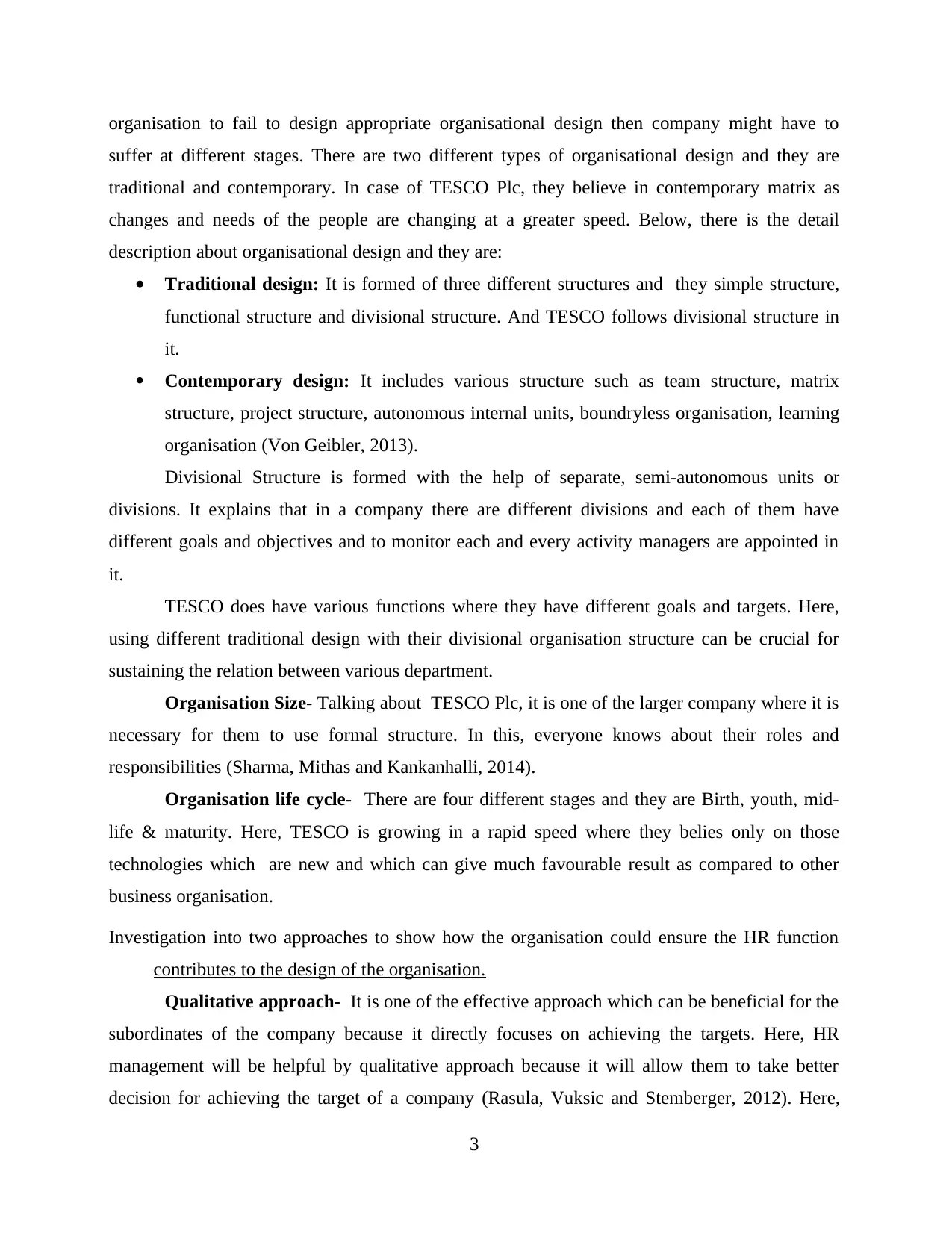
organisation to fail to design appropriate organisational design then company might have to
suffer at different stages. There are two different types of organisational design and they are
traditional and contemporary. In case of TESCO Plc, they believe in contemporary matrix as
changes and needs of the people are changing at a greater speed. Below, there is the detail
description about organisational design and they are:
Traditional design: It is formed of three different structures and they simple structure,
functional structure and divisional structure. And TESCO follows divisional structure in
it.
Contemporary design: It includes various structure such as team structure, matrix
structure, project structure, autonomous internal units, boundryless organisation, learning
organisation (Von Geibler, 2013).
Divisional Structure is formed with the help of separate, semi-autonomous units or
divisions. It explains that in a company there are different divisions and each of them have
different goals and objectives and to monitor each and every activity managers are appointed in
it.
TESCO does have various functions where they have different goals and targets. Here,
using different traditional design with their divisional organisation structure can be crucial for
sustaining the relation between various department.
Organisation Size- Talking about TESCO Plc, it is one of the larger company where it is
necessary for them to use formal structure. In this, everyone knows about their roles and
responsibilities (Sharma, Mithas and Kankanhalli, 2014).
Organisation life cycle- There are four different stages and they are Birth, youth, mid-
life & maturity. Here, TESCO is growing in a rapid speed where they belies only on those
technologies which are new and which can give much favourable result as compared to other
business organisation.
Investigation into two approaches to show how the organisation could ensure the HR function
contributes to the design of the organisation.
Qualitative approach- It is one of the effective approach which can be beneficial for the
subordinates of the company because it directly focuses on achieving the targets. Here, HR
management will be helpful by qualitative approach because it will allow them to take better
decision for achieving the target of a company (Rasula, Vuksic and Stemberger, 2012). Here,
3
suffer at different stages. There are two different types of organisational design and they are
traditional and contemporary. In case of TESCO Plc, they believe in contemporary matrix as
changes and needs of the people are changing at a greater speed. Below, there is the detail
description about organisational design and they are:
Traditional design: It is formed of three different structures and they simple structure,
functional structure and divisional structure. And TESCO follows divisional structure in
it.
Contemporary design: It includes various structure such as team structure, matrix
structure, project structure, autonomous internal units, boundryless organisation, learning
organisation (Von Geibler, 2013).
Divisional Structure is formed with the help of separate, semi-autonomous units or
divisions. It explains that in a company there are different divisions and each of them have
different goals and objectives and to monitor each and every activity managers are appointed in
it.
TESCO does have various functions where they have different goals and targets. Here,
using different traditional design with their divisional organisation structure can be crucial for
sustaining the relation between various department.
Organisation Size- Talking about TESCO Plc, it is one of the larger company where it is
necessary for them to use formal structure. In this, everyone knows about their roles and
responsibilities (Sharma, Mithas and Kankanhalli, 2014).
Organisation life cycle- There are four different stages and they are Birth, youth, mid-
life & maturity. Here, TESCO is growing in a rapid speed where they belies only on those
technologies which are new and which can give much favourable result as compared to other
business organisation.
Investigation into two approaches to show how the organisation could ensure the HR function
contributes to the design of the organisation.
Qualitative approach- It is one of the effective approach which can be beneficial for the
subordinates of the company because it directly focuses on achieving the targets. Here, HR
management will be helpful by qualitative approach because it will allow them to take better
decision for achieving the target of a company (Rasula, Vuksic and Stemberger, 2012). Here,
3
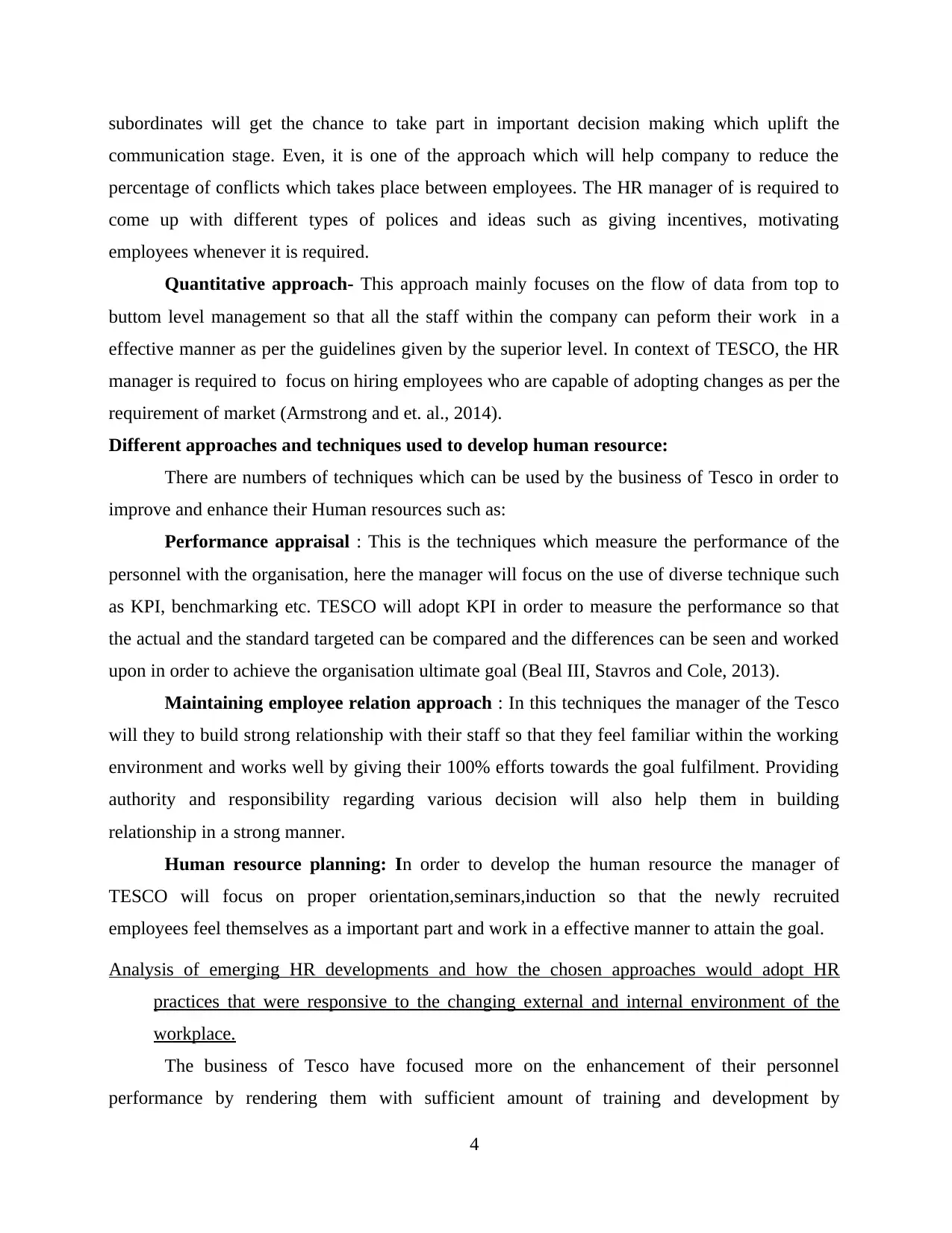
subordinates will get the chance to take part in important decision making which uplift the
communication stage. Even, it is one of the approach which will help company to reduce the
percentage of conflicts which takes place between employees. The HR manager of is required to
come up with different types of polices and ideas such as giving incentives, motivating
employees whenever it is required.
Quantitative approach- This approach mainly focuses on the flow of data from top to
buttom level management so that all the staff within the company can peform their work in a
effective manner as per the guidelines given by the superior level. In context of TESCO, the HR
manager is required to focus on hiring employees who are capable of adopting changes as per the
requirement of market (Armstrong and et. al., 2014).
Different approaches and techniques used to develop human resource:
There are numbers of techniques which can be used by the business of Tesco in order to
improve and enhance their Human resources such as:
Performance appraisal : This is the techniques which measure the performance of the
personnel with the organisation, here the manager will focus on the use of diverse technique such
as KPI, benchmarking etc. TESCO will adopt KPI in order to measure the performance so that
the actual and the standard targeted can be compared and the differences can be seen and worked
upon in order to achieve the organisation ultimate goal (Beal III, Stavros and Cole, 2013).
Maintaining employee relation approach : In this techniques the manager of the Tesco
will they to build strong relationship with their staff so that they feel familiar within the working
environment and works well by giving their 100% efforts towards the goal fulfilment. Providing
authority and responsibility regarding various decision will also help them in building
relationship in a strong manner.
Human resource planning: In order to develop the human resource the manager of
TESCO will focus on proper orientation,seminars,induction so that the newly recruited
employees feel themselves as a important part and work in a effective manner to attain the goal.
Analysis of emerging HR developments and how the chosen approaches would adopt HR
practices that were responsive to the changing external and internal environment of the
workplace.
The business of Tesco have focused more on the enhancement of their personnel
performance by rendering them with sufficient amount of training and development by
4
communication stage. Even, it is one of the approach which will help company to reduce the
percentage of conflicts which takes place between employees. The HR manager of is required to
come up with different types of polices and ideas such as giving incentives, motivating
employees whenever it is required.
Quantitative approach- This approach mainly focuses on the flow of data from top to
buttom level management so that all the staff within the company can peform their work in a
effective manner as per the guidelines given by the superior level. In context of TESCO, the HR
manager is required to focus on hiring employees who are capable of adopting changes as per the
requirement of market (Armstrong and et. al., 2014).
Different approaches and techniques used to develop human resource:
There are numbers of techniques which can be used by the business of Tesco in order to
improve and enhance their Human resources such as:
Performance appraisal : This is the techniques which measure the performance of the
personnel with the organisation, here the manager will focus on the use of diverse technique such
as KPI, benchmarking etc. TESCO will adopt KPI in order to measure the performance so that
the actual and the standard targeted can be compared and the differences can be seen and worked
upon in order to achieve the organisation ultimate goal (Beal III, Stavros and Cole, 2013).
Maintaining employee relation approach : In this techniques the manager of the Tesco
will they to build strong relationship with their staff so that they feel familiar within the working
environment and works well by giving their 100% efforts towards the goal fulfilment. Providing
authority and responsibility regarding various decision will also help them in building
relationship in a strong manner.
Human resource planning: In order to develop the human resource the manager of
TESCO will focus on proper orientation,seminars,induction so that the newly recruited
employees feel themselves as a important part and work in a effective manner to attain the goal.
Analysis of emerging HR developments and how the chosen approaches would adopt HR
practices that were responsive to the changing external and internal environment of the
workplace.
The business of Tesco have focused more on the enhancement of their personnel
performance by rendering them with sufficient amount of training and development by
4
⊘ This is a preview!⊘
Do you want full access?
Subscribe today to unlock all pages.

Trusted by 1+ million students worldwide
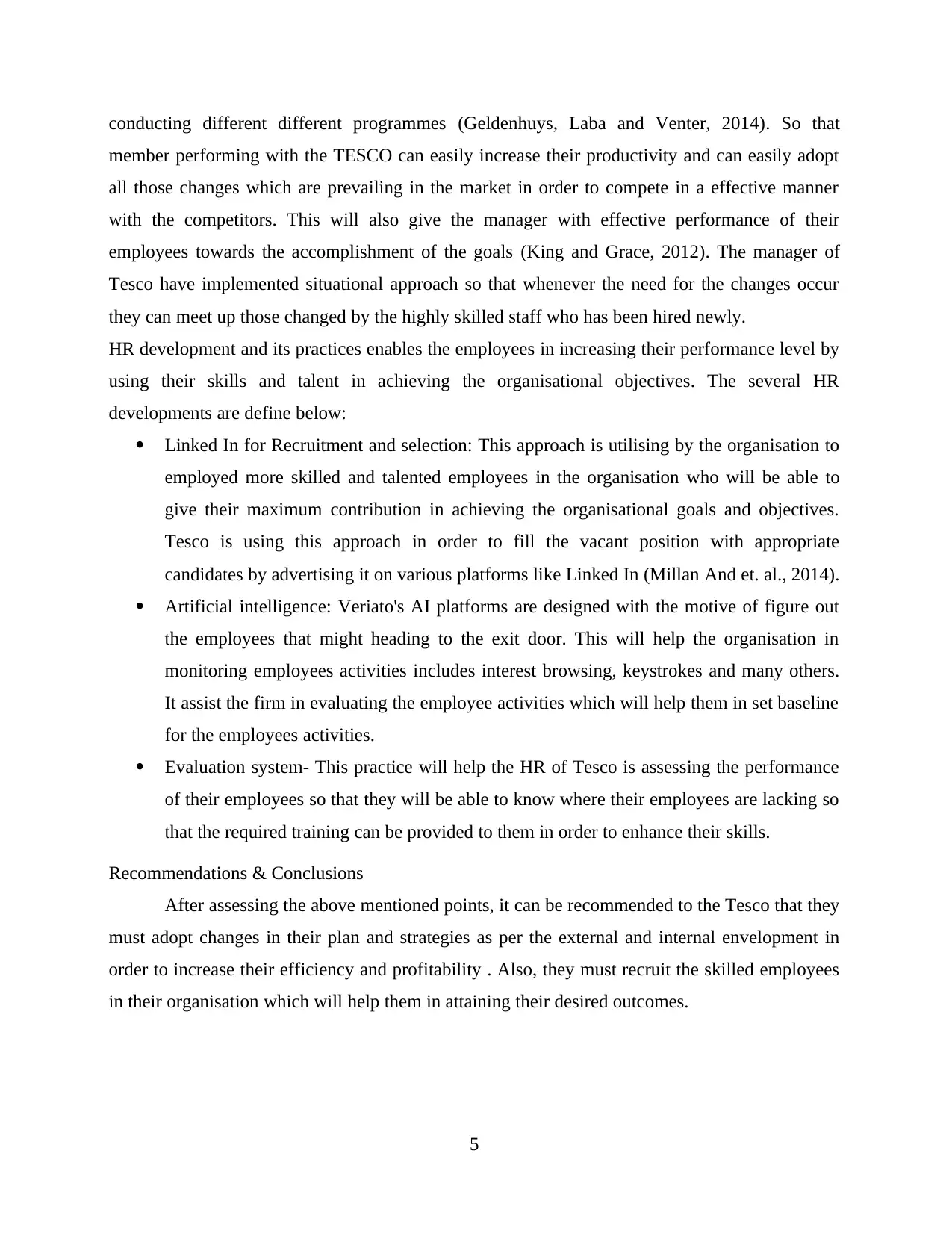
conducting different different programmes (Geldenhuys, Laba and Venter, 2014). So that
member performing with the TESCO can easily increase their productivity and can easily adopt
all those changes which are prevailing in the market in order to compete in a effective manner
with the competitors. This will also give the manager with effective performance of their
employees towards the accomplishment of the goals (King and Grace, 2012). The manager of
Tesco have implemented situational approach so that whenever the need for the changes occur
they can meet up those changed by the highly skilled staff who has been hired newly.
HR development and its practices enables the employees in increasing their performance level by
using their skills and talent in achieving the organisational objectives. The several HR
developments are define below:
Linked In for Recruitment and selection: This approach is utilising by the organisation to
employed more skilled and talented employees in the organisation who will be able to
give their maximum contribution in achieving the organisational goals and objectives.
Tesco is using this approach in order to fill the vacant position with appropriate
candidates by advertising it on various platforms like Linked In (Millan And et. al., 2014).
Artificial intelligence: Veriato's AI platforms are designed with the motive of figure out
the employees that might heading to the exit door. This will help the organisation in
monitoring employees activities includes interest browsing, keystrokes and many others.
It assist the firm in evaluating the employee activities which will help them in set baseline
for the employees activities.
Evaluation system- This practice will help the HR of Tesco is assessing the performance
of their employees so that they will be able to know where their employees are lacking so
that the required training can be provided to them in order to enhance their skills.
Recommendations & Conclusions
After assessing the above mentioned points, it can be recommended to the Tesco that they
must adopt changes in their plan and strategies as per the external and internal envelopment in
order to increase their efficiency and profitability . Also, they must recruit the skilled employees
in their organisation which will help them in attaining their desired outcomes.
5
member performing with the TESCO can easily increase their productivity and can easily adopt
all those changes which are prevailing in the market in order to compete in a effective manner
with the competitors. This will also give the manager with effective performance of their
employees towards the accomplishment of the goals (King and Grace, 2012). The manager of
Tesco have implemented situational approach so that whenever the need for the changes occur
they can meet up those changed by the highly skilled staff who has been hired newly.
HR development and its practices enables the employees in increasing their performance level by
using their skills and talent in achieving the organisational objectives. The several HR
developments are define below:
Linked In for Recruitment and selection: This approach is utilising by the organisation to
employed more skilled and talented employees in the organisation who will be able to
give their maximum contribution in achieving the organisational goals and objectives.
Tesco is using this approach in order to fill the vacant position with appropriate
candidates by advertising it on various platforms like Linked In (Millan And et. al., 2014).
Artificial intelligence: Veriato's AI platforms are designed with the motive of figure out
the employees that might heading to the exit door. This will help the organisation in
monitoring employees activities includes interest browsing, keystrokes and many others.
It assist the firm in evaluating the employee activities which will help them in set baseline
for the employees activities.
Evaluation system- This practice will help the HR of Tesco is assessing the performance
of their employees so that they will be able to know where their employees are lacking so
that the required training can be provided to them in order to enhance their skills.
Recommendations & Conclusions
After assessing the above mentioned points, it can be recommended to the Tesco that they
must adopt changes in their plan and strategies as per the external and internal envelopment in
order to increase their efficiency and profitability . Also, they must recruit the skilled employees
in their organisation which will help them in attaining their desired outcomes.
5
Paraphrase This Document
Need a fresh take? Get an instant paraphrase of this document with our AI Paraphraser
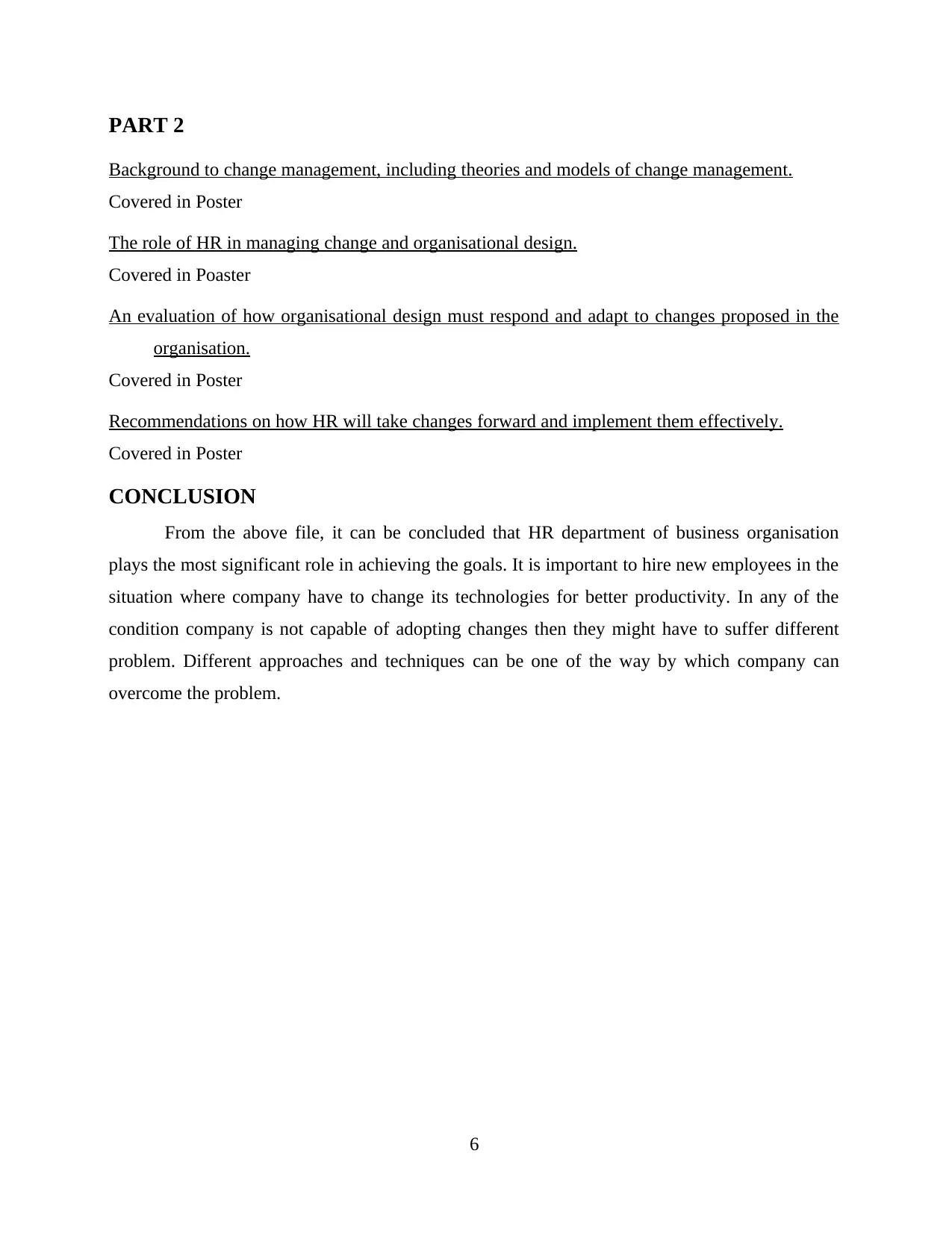
PART 2
Background to change management, including theories and models of change management.
Covered in Poster
The role of HR in managing change and organisational design.
Covered in Poaster
An evaluation of how organisational design must respond and adapt to changes proposed in the
organisation.
Covered in Poster
Recommendations on how HR will take changes forward and implement them effectively.
Covered in Poster
CONCLUSION
From the above file, it can be concluded that HR department of business organisation
plays the most significant role in achieving the goals. It is important to hire new employees in the
situation where company have to change its technologies for better productivity. In any of the
condition company is not capable of adopting changes then they might have to suffer different
problem. Different approaches and techniques can be one of the way by which company can
overcome the problem.
6
Background to change management, including theories and models of change management.
Covered in Poster
The role of HR in managing change and organisational design.
Covered in Poaster
An evaluation of how organisational design must respond and adapt to changes proposed in the
organisation.
Covered in Poster
Recommendations on how HR will take changes forward and implement them effectively.
Covered in Poster
CONCLUSION
From the above file, it can be concluded that HR department of business organisation
plays the most significant role in achieving the goals. It is important to hire new employees in the
situation where company have to change its technologies for better productivity. In any of the
condition company is not capable of adopting changes then they might have to suffer different
problem. Different approaches and techniques can be one of the way by which company can
overcome the problem.
6
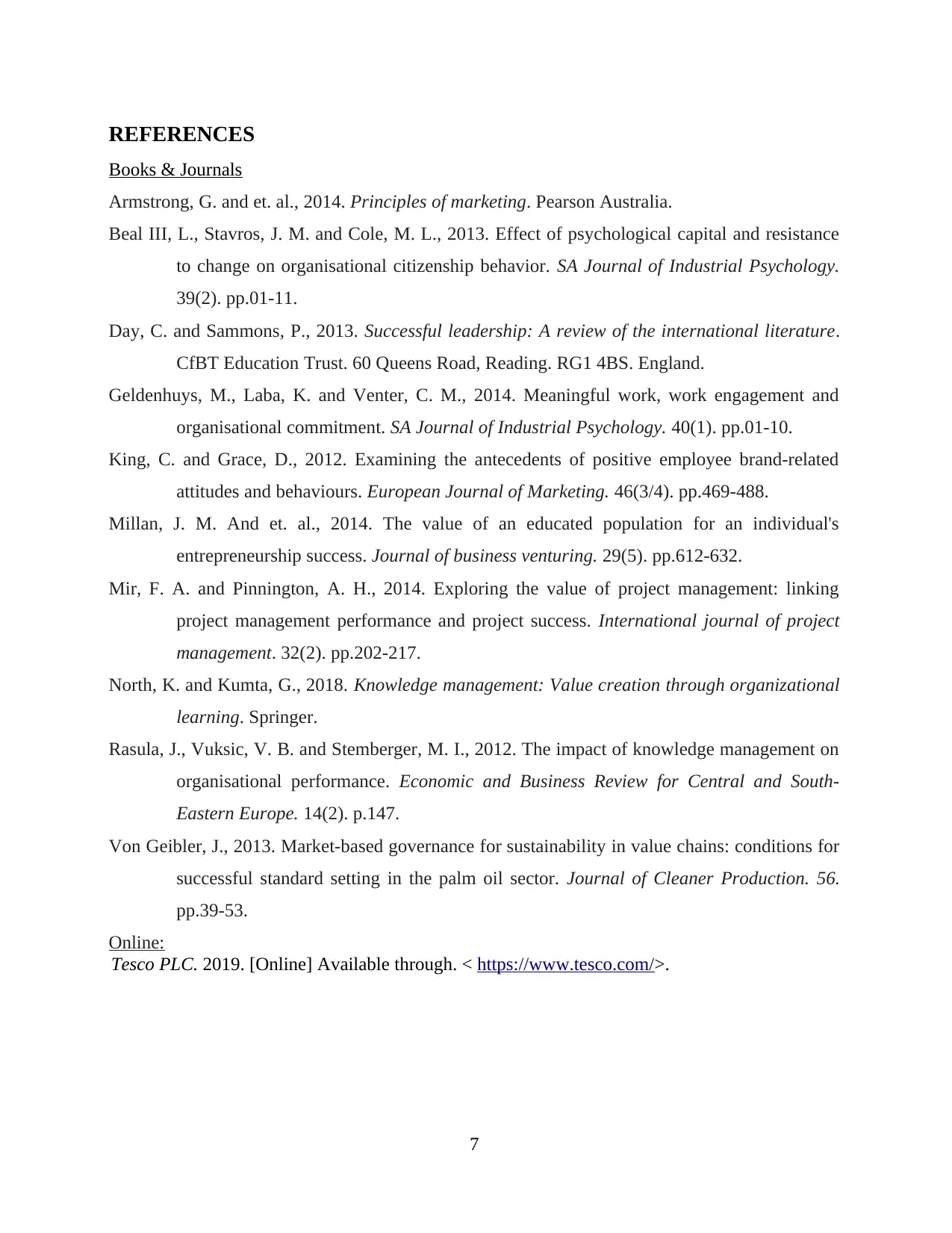
REFERENCES
Books & Journals
Armstrong, G. and et. al., 2014. Principles of marketing. Pearson Australia.
Beal III, L., Stavros, J. M. and Cole, M. L., 2013. Effect of psychological capital and resistance
to change on organisational citizenship behavior. SA Journal of Industrial Psychology.
39(2). pp.01-11.
Day, C. and Sammons, P., 2013. Successful leadership: A review of the international literature.
CfBT Education Trust. 60 Queens Road, Reading. RG1 4BS. England.
Geldenhuys, M., Laba, K. and Venter, C. M., 2014. Meaningful work, work engagement and
organisational commitment. SA Journal of Industrial Psychology. 40(1). pp.01-10.
King, C. and Grace, D., 2012. Examining the antecedents of positive employee brand-related
attitudes and behaviours. European Journal of Marketing. 46(3/4). pp.469-488.
Millan, J. M. And et. al., 2014. The value of an educated population for an individual's
entrepreneurship success. Journal of business venturing. 29(5). pp.612-632.
Mir, F. A. and Pinnington, A. H., 2014. Exploring the value of project management: linking
project management performance and project success. International journal of project
management. 32(2). pp.202-217.
North, K. and Kumta, G., 2018. Knowledge management: Value creation through organizational
learning. Springer.
Rasula, J., Vuksic, V. B. and Stemberger, M. I., 2012. The impact of knowledge management on
organisational performance. Economic and Business Review for Central and South-
Eastern Europe. 14(2). p.147.
Von Geibler, J., 2013. Market-based governance for sustainability in value chains: conditions for
successful standard setting in the palm oil sector. Journal of Cleaner Production. 56.
pp.39-53.
Online:
Tesco PLC. 2019. [Online] Available through. < https://www.tesco.com/>.
7
Books & Journals
Armstrong, G. and et. al., 2014. Principles of marketing. Pearson Australia.
Beal III, L., Stavros, J. M. and Cole, M. L., 2013. Effect of psychological capital and resistance
to change on organisational citizenship behavior. SA Journal of Industrial Psychology.
39(2). pp.01-11.
Day, C. and Sammons, P., 2013. Successful leadership: A review of the international literature.
CfBT Education Trust. 60 Queens Road, Reading. RG1 4BS. England.
Geldenhuys, M., Laba, K. and Venter, C. M., 2014. Meaningful work, work engagement and
organisational commitment. SA Journal of Industrial Psychology. 40(1). pp.01-10.
King, C. and Grace, D., 2012. Examining the antecedents of positive employee brand-related
attitudes and behaviours. European Journal of Marketing. 46(3/4). pp.469-488.
Millan, J. M. And et. al., 2014. The value of an educated population for an individual's
entrepreneurship success. Journal of business venturing. 29(5). pp.612-632.
Mir, F. A. and Pinnington, A. H., 2014. Exploring the value of project management: linking
project management performance and project success. International journal of project
management. 32(2). pp.202-217.
North, K. and Kumta, G., 2018. Knowledge management: Value creation through organizational
learning. Springer.
Rasula, J., Vuksic, V. B. and Stemberger, M. I., 2012. The impact of knowledge management on
organisational performance. Economic and Business Review for Central and South-
Eastern Europe. 14(2). p.147.
Von Geibler, J., 2013. Market-based governance for sustainability in value chains: conditions for
successful standard setting in the palm oil sector. Journal of Cleaner Production. 56.
pp.39-53.
Online:
Tesco PLC. 2019. [Online] Available through. < https://www.tesco.com/>.
7
⊘ This is a preview!⊘
Do you want full access?
Subscribe today to unlock all pages.

Trusted by 1+ million students worldwide
1 out of 9
Related Documents
Your All-in-One AI-Powered Toolkit for Academic Success.
+13062052269
info@desklib.com
Available 24*7 on WhatsApp / Email
![[object Object]](/_next/static/media/star-bottom.7253800d.svg)
Unlock your academic potential
Copyright © 2020–2025 A2Z Services. All Rights Reserved. Developed and managed by ZUCOL.




